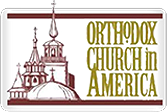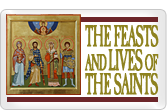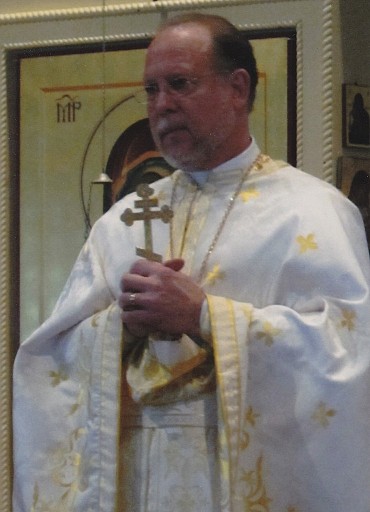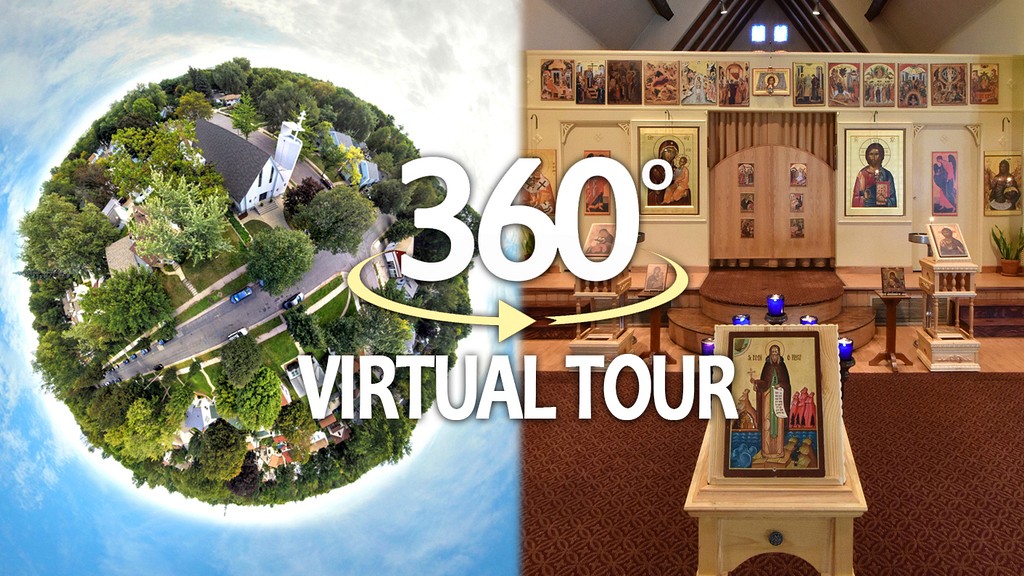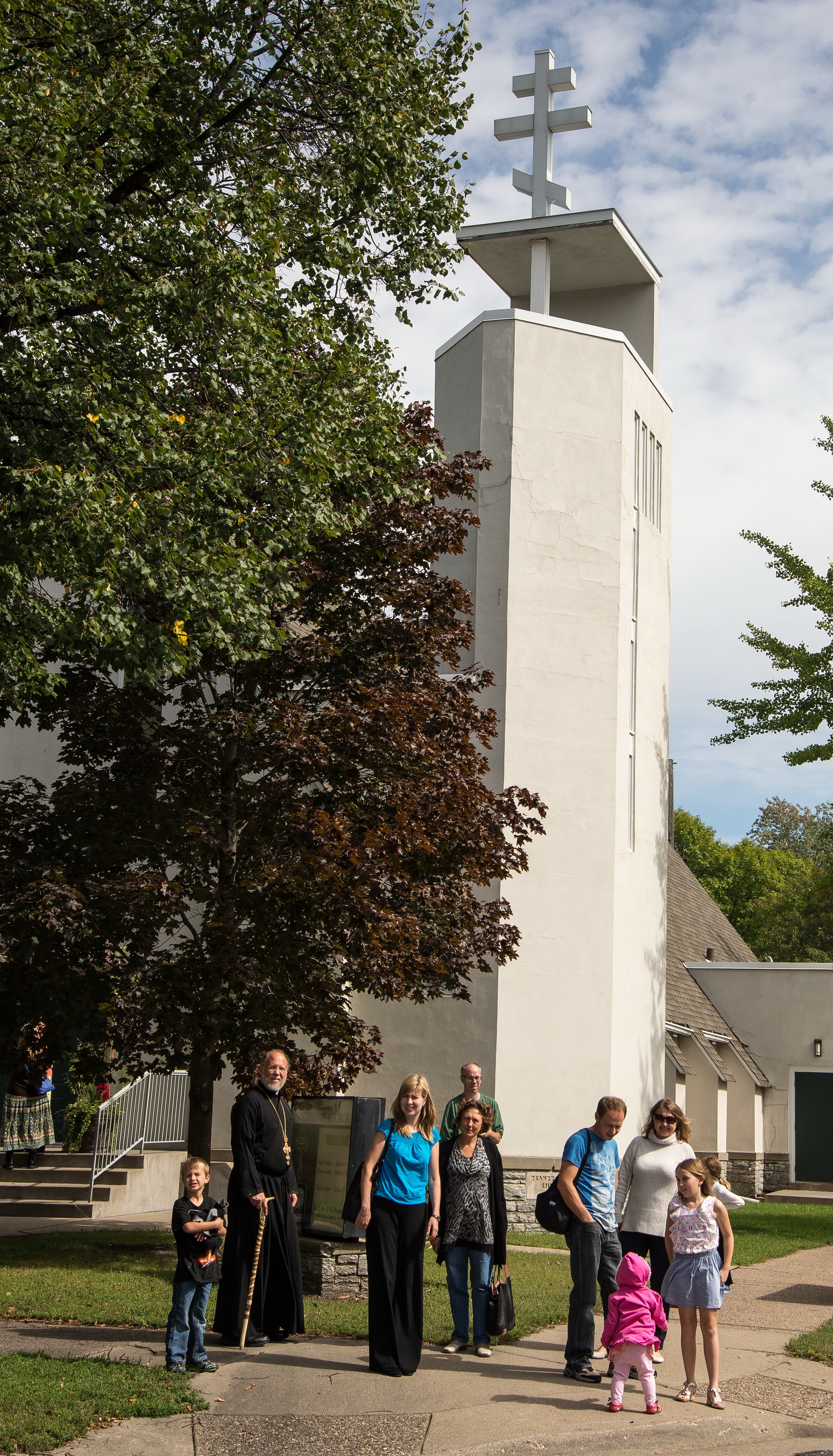THE WEDDING GARMENT OF THE ICON
Hebrews 11.24 – 26, 32 – 12.2
John 1.43 – 51
This morning, we hear the word of the WORD of God, Jesus Christ, the Icon of the invisible God [Col 1.15], to His icon, Nathanael – and therefore, to each one of us, for we are each one an icon of the Icon, Jesus Christ: ‘Hereafter,’ He says to Nathanael and to us, ‘you shall see heaven open, and the angels of God ascending and descending upon the Son of Man.’ [Jn 1.51]
One can see all the words of the OT, of Moses, the Psalms, and the prophets gathered together in this WORD of the LORD to Nathanael. It proclaims the New Testament, the WORD of God becoming flesh of the Holy Virgin. He descends to earth on the heavenly Ladder Jacob saw in his dream. Like Jacob searching for his bride, Rachel, the Heavenly Bridegroom descends the Ladder to come looking for us. In the Holy of Holies of the Living Temple that is His Mother, the Holy Virgin, He weaves a garment from Her pure blood.
This is the Wedding Garment of His flesh and blood in which we are clothed when we unite ourselves to Him in Holy Baptism. Clothed in the Wedding Garment of His flesh, He dwells among us and calls us to Himself in the Bridal Chamber of our heart. His Exodus is from His Heavenly Home with the Father and the Holy Spirit to the Cross with us. Blessed Augustine calls the Cross the marriage bed, for it is on the Cross that the Heavenly Bridegroom consummates His union with us. His Body, the Wedding Garment, is taken down from the Cross lovingly by Joseph of Arimathea. It is ‘clothed’ in fine linen, and placed in the virginal Tomb, as Adam was placed in the Garden.
Now, the Tomb, says St Macarios of Egypt [4th cent], is the tomb of our heart. Our heart, says St Kallistos Angelikoudes [14th cent], is the mystery depicted in the biblical icon of Eden. Our heart, says the prophet, Jeremiah, is ‘deep, beyond all things, and it is the man.’ [Jer 17.9] In our heart, says St Nicodemus the Hagiorite [18th cent] is our intellect, the spiritual organ within us that St Paul says is the organ of knowing ourselves in the Spirit of God [1 Cor 2.11], and that St Gregory the Theologian [4th cent] identifies as the most essential part of our nature. It is the ‘eye’ of the body that is able by nature to receive and become one with the uncreated Light of God, and in that Light, to see God and to know God. It is that deep of our heart that is depicted, I think it may be, by that space on the Edenic Mountain between the tree of learning good and evil that was halfway up the mountain, and the Tree of Life that was at the top of the mountain – as we learn from St Ephrem the Syrian in his Hymns on Paradise [4th cent].
Adam and Eve never entered that ‘space between.’ When they disobeyed the command, they chose to be lovers of their own beauty in the conceit of their own wisdom [Prov 3.5-7], not lovers of the Beauty of the Wisdom of God in whom they were made [Wisd 8.2]. They did not complete the primordial Exodus of the Bible; they did not ascend from the tree of learning good and evil to the Tree of Life. Instead, they were expelled. They went down the Mountain of Eden and out into the hill country ‘opposite’ Eden [Gn 3.25 LXX]
And what does it say? ‘Immediately,’ upon their transgression, ‘their eyes were opened, and they knew that they were naked.’ They had been stripped of the Wedding Garment, clothed no more in the Glory and Power of Divine Wisdom, dwelling now outside the Icon of the invisible God, Jesus Christ, the Heavenly Bridegroom, outside the Wedding Garment in whom they had come to be and in whose Glory they had been clothed. For, they had received into their soul the seed of the wisdom of the serpent, not the Seed of the Wisdom of God. They had made the serpent, not Divine Wisdom, their spouse [Wisd 8.2]. But instead of acknowledging their sin in repentance, they clothed themselves in fig leaves, a garment of shame, hoping to hide their shame by pinning their guilt on the other.
The LORD says to Nathanael, and to all who without guile turn their face eastward seeking Divine Wisdom with all diligence in the repentance of faith, ‘‘Hereafter, you shall see heaven opening, and the angels of God ascending and descending upon the Son of Man.’ Adam and Eve did not see the heavens opening and the angels ascending and descending on the Son of Man. What is that vision they did not see? It is the mystery of God hidden from the ages, the mystery of Christ, the Heavenly Bridegroom, descending the Ladder of the Holy Virgin all the way into the Tomb of our heart to abide in us, to transfigure it into the Bridal Chamber, and to clothe us with the Wedding Garment in the Glory of His Body woven from the Virgin’s most pure blood. Instead, they saw that they were naked.
As it says in the Wisdom of Solomon: ‘The LORD is not found in those who tempt Him and distrust Him, whose thoughts are crooked, whose soul has been conformed to evil and has been given to sin and deceit, who despises discipline, whose thoughts are without understanding,’ – i.e., whose thoughts dwell not on the Wisdom of God but on the wisdom of the serpent in the conceit of human wisdom as though it was divine Wisdom.
It is true that with our prose we are talking poetically. But the Beauty of Divine Wisdom, the Heavenly Bridegroom, depicted by the bible’s poetic images is not religious fiction. It is absolutely real. The poetic imagery of the Bible is meant to open our inner eye to see, far beyond our nakedness, the Beauty of the Wedding Garment, the Glory of Christ, that clothed us as icons in the Icon of Christ, and were made to live and move and have our being in the Wedding Garment of the pre-eternal Glory of the Heavenly Bridegroom, in the personal communion, in the Wedding Garment, of the Holy Trinity.
No one, it says in the Gospels, had ever been ‘placed’ in the LORD’s Tomb. That is a poetic icon of history revealing the invisible reality flowing like an artesian spring beneath the ground of history. Illumined by other images in Holy Scripture [e.g. Heb 8.7; Mt 27.51], we see it signifying that no one, from the time of Adam and Eve to Christ and His Holy Mother, the New Adam and the New Eve, had entered that space of the deep heart between the tree of learning good and evil and the Tree of Life, the inmost sanctuary of the human heart beyond the ‘iconostas’ of the ‘firmament’ that divides heaven and earth, where we are each one deep, beyond all things and open out onto the eternal God. And so, the bridal chamber of our heart had become a desolate place, a tomb, the ‘place of the skull.’ For, we all like sheep have gone astray; we have turned every one of us to our own way. [Isa 53.6]
This is not religious fiction, I said. It is absolutely real. What then, dear ones, might be the reality depicted by the poetic image of the ‘nakedness’ Adam and Eve came to know when their inner eye, the lamp of their body, was opened? Is it not the dark boredom empty of meaning, the crippling aloneness each one of us sees within ourselves when we turn our inner eye away from all our escapes and diversions, and seek to hide by taking refuge in our idols?
Wisdom comes from the LORD, we read in Proverbs last Wednesday; for the Wisdom of God is Christ whose uncreated Glory is Light and Life and divine Beauty. This is the Wedding Garment in which we were originally clothed, and in which we were meant to ‘rest’ in union with the Heavenly Bridegroom in the Bridal Chamber of our heart. This Wedding Garment is not the wisdom that comes from human philosophy, or from the scholarship of the universities, or from the sciences. Most certainly it is not found on our phones. We will not be clothed in the Glory of the Wedding Garment with the images and videos and YouTubes on the screens. All of these leave us ‘naked,’ empty of meaning or purpose, bored in our heart where we are deep, beyond all things.
Only the Spirit of God fills the tomb of our heart with the Wisdom of Christ God risen from the dead, and clothes our nakedness in the Wedding Garment of the Heavenly Bridegroom to transform the tomb of our heart into a Bridal Chamber. We begin putting on that Wedding Garment when we cast off the garments of fig leaves in repentance and begin to seek Divine Wisdom, the LORD Jesus Christ, in the Bridal Chamber of our heart by beginning to live according to His commandments.
The Bridal Chamber, dear ones, is the Church. For the Church is the place where the union of God and man is accomplished visibly, in our physical bodies, in the sacramental mystery of the Incarnation. This is not religious fiction. We can know its reality when we turn our inner eye inward to follow the invisible Path of repentance according to the icons of the Church that make it visible. If our desire is to find the Bridal Chamber within us, in the deep of our heart, well, we must come to the Church, and we must live in the Church. Coming into the visible Church, we come into the invisible Wedding Garment. If we strive to live in that Wedding Garment by walking in the way of the LORD’s commandments in our thoughts, our actions, our words, we may hope to see the heavens opening and the angels of God ascending and descending on the Son of Man in the Tomb of His Holy Pascha, the mystery of the Bridal Chamber that is within us, in our own heart. Amen! Most Holy Theotokos, save us! Glory to Jesus Christ!
Matthew 21.18-43
Shortly, we will venerate the Icon and sing the beautiful Hymn of Light: ‘Thy Bridal Chamber I see adorned, O my Savior; and I have no wedding garment that I may enter! O Giver of Light, enlighten the vesture of my soul and save me!’ What is the Bridal Chamber? What is the wedding garment?
Do you know that your Holy Baptism, when you were united to Christ in the likeness of His death and resurrection, is the Spiritual Marriage of the Church? Raised from the Font, the heavens were opened to you. You were clothed in the Robe of Light, which was Christ Himself. This is the ‘wedding garment.’ When you drew near the Chalice in the fear of God, with faith and love, you partook of the Marriage Feast of the Lamb.
From the moment of your baptism, when heaven was opened to you, have there not been moments in the worship of the Church when the beauty of the Church’s hymns and prayers, the fragrance of her incense, the serene countenance of the holy icons gazing down on you, the spiritual nobility and majesty of the Divine Liturgy, seized your soul and opened to you, if only for an instant, a spiritual Beauty not of this world, and there stirred within you, as it did in Solomon, a visceral love for that Beauty and a longing to make the Wisdom of God your spouse? (Wisd 8.2)
Might this be a vision of the bridal chamber that was opened to you at your baptism?
‘Thy Bridal Chamber I see adorned, O my Savior! And I have no wedding garment that I may enter!’ As Lazarus was clothed in grave clothes, soiled and stinking from his being four days in the tomb, do we not see, if ever a vision of the bridal chamber is opened to us, that we have no wedding garment? Our garments are soiled and stinking grave clothes.
The wedding garment that clothed us in our baptism is Christ the LORD. The LORD, says the Psalmist, is my life and my salvation. And St Paul says, Christ is my life. Christ Himself says to Mary and Martha: I am the Resurrection and the Life.
From this, we can see that the garment is an image of the life we are living; and there are two garments, two lives we may choose to live or choose to put on as we choose to put on a garment. There is the garment of the life of this world that is passing away, sewn with threads of corruption spun from the passions, from the lust of the eyes, the lust of the flesh, the pride of life, from covetousness, which is idolatry. Its patterns and designs are cut out from the lustful thoughts and impure images, the fantasies and desires that occupy the mind.
Then there is the life of Christ, the wedding garment that clothed us in our baptism. If I have no wedding garment that I may enter the sacred bridal chamber of the Heavenly Bridegroom, can you see that it’s because I have given my soul to many husbands; I have chosen Caesar to be my king; I have given myself to the idols of the passions—gluttony, lust, greed, anger and the rest—and that the garments I have chosen to wear are the grave clothes of the corruption that is in the world through lust and covetousness?
‘Despising the divine commands, my soul,’ Mother Church calls out to us at Friday Matins of last week, ‘by thine own choice, thou hast surrendered thyself to corruption. Sunk in slumber through thy many trespasses, thou hast covered with filth the garment that God wove for thee, and made thyself unfit for the wedding of the King. Therefore, cry to the Savior: Tear in pieces my sackcloth and clothe me with gladness.’ (LTS 306)
You have chosen to come to this Bridegroom Matins service. You have chosen to come into the presence of the Bridegroom. You have chosen to draw near the Bridal Chamber; and the Bridegroom comes to us in our filthy grave clothes as He came to Lazarus in Bethany. I think we may say that in the beauty of these Bridegroom Matins, we hear Him crying to each one of us: ‘Come forth!’ Rouse yourself in the tomb of your heart. Hear, feel, the Bridegroom’s voice calling to you. Leave the grave clothes, the garment of this worldly life behind you. What keeps us from putting on the garment of the Savior’s divine commandments? Is it not our own choice to keep wearing the grave clothes of this life? I love those who love me, says the Bridegroom. Those who seek me diligently will find me! Nothing prevents us from choosing to heed the Bridegroom’s call, to rise up and come forth in the repentance of a broken and contrite heart, that the Bridegroom may illumine the vesture of our soul and save us and receive us, clothed again in the wedding garment of our baptism, into the Bridal Chamber of His Holy Resurrection. Amen!
Behold the Bridegroom comes at Midnight!’ Midnight is that ‘instant’ when, ‘in the twinkling of an eye,’ (1 Cor 15.52) the old passes away and the ‘dead are raised incorruptible, and we are changed.’ This change doesn’t just happen. It happens because the Bridegroom comes at Midnight and consummates His union with us, the children of flesh and blood, in the ‘bridal chamber.’ But the Church shows the Bridegroom consummating His union with us in the tomb. For there, having shared in our conception and birth through His Virgin Mother (Gal 4.4), He now shares in our death (Heb 2.14) in the flesh He received from Her, and it is in that instant that ‘we are changed.’
We find the divine mystery of Midnight, then, in the bridal chamber; and we find the bridal chamber in that ‘point’ in our inner man where we are dead. The bridal chamber, that is to say, is found in our heart, ‘for the real death is within, in the heart, and is concealed, and it is the inner man that perishes.’ [Macarius Hom XV.39, 125]
If the bridal chamber is in the heart, then it is in our true ‘self’; for ‘the heart is deep, beyond all things, and it is the man.’ [Jer 17.9] In the bridal chamber, then, we come upon our true self as the image of God. In this image, we yearn to attain to the likeness of God. And this character of the imago Dei which, as Origen wrote, constitutes our very essence, itself reveals that, by nature, we yearn to be one with the Bridegroom in the bridal chamber of our heart; but if Christ is Himself the Image of God in whom we came to be and in whom we move and have our being, then we are given to see that the bridal chamber of our heart comes to be and has its essence and movement from outside itself, in ekstasis, in the Bridal Chamber of the LORD Jesus Christ our God and Savior.
Illumined by the light of this doctrine of the Church, we begin to know ourselves. We see that the essential movement of our heart is the erotic yearning to belong not to ourselves but to the Bridegroom who comes at Midnight.
And so, when the mind that has caught the fragrance of the Bridegroom in its heart learns that the Bridegroom is coming at Midnight, it rouses itself. It hastens to descend into the bridal chamber of the heart to cry out: ‘Holy, Holy, Holy art Thou, O God! Through the Theotokos, have mercy on me!’ For the soul, if she only knows about God in her head, she is still dead and her heart is still stone. The soul who longs to live is the soul who longs to know God directly; but ‘there is no direct knowledge of God without an exceedingly great love, and such love does not come from the head. It must come from the heart.’ [Art of Prayer 20] And so the soul hastens to descend with her mind into the bridal chamber of her heart, for she longs to receive Him and to cleave to Him, to become bone of His bones and flesh of His flesh, so that it is no longer she who lives but the Bridegroom who lives in her.
And the Bridegroom comes. He comes to us in our own flesh and blood through the woman [Gal 4.4]. He comes to us in the Bridal Chamber of the All-Holy Virgin’s sacred womb, in the inmost sanctuary of His Living Temple. Knitting Her pure blood into the ‘schema,’ the ‘garment’ of man [Phil 2.8], He clothed Himself in our flesh and blood and was no more ashamed to call us ‘brethren.’ [Heb 2.11]
And when the soul darkened and weighed down by her many sins, learns that He has come into the ‘house’ [Lk 7.37ff.] of her own flesh and blood [Heb 2.14], she comes to Him with an alabaster jar of perfume, and she stands behind Him weeping. She wets His pure feet with her tears and wipes them with her hair. She kisses them, she pours perfume on them, and through her tears, she prays to Him softly: ‘Thy bridal chamber I see adorned, O my Savior; but I have no wedding garment that I may enter. O Giver of Light, enlighten the vesture of my soul and save me!’
And the Savior, ‘spellbound as it were by goodness, love and longing, relinquishes His utter transcendence’ [St Maximos Philo 281] to the point of death on the Cross. Partaking of our death, the Bridegroom breathes out His Spirit on the Cross [exepneusen, Lk 23.46] and destroys the death that separated us from His love in the bridal chamber of our heart;’ [Heb 2.14-15, Rom 8.39]. His Body was ‘placed in the tomb,’ the Tomb was ‘changed’ into the Bridal Chamber, ‘and the Sabbath dawned,’ says St Luke [epephosken, Lk 23.54]. And in the Bridal Chamber of the LORD’s Tomb, the soul was enlightened, and the heart that before was a tomb sealed off by a stone was ‘changed’ in that instant into a bridal chamber and into a heart of flesh, a living heart!
The wedding garment? It is Christ Himself, whose Light we put on when we were raised from the Font, having united ourselves to Christ in the likeness of His death and resurrection. Can you see, then, that the Baptismal Font is the bridal chamber? And can you see that the Bridal Chamber is the Church? For the Church is Christ’s Body that He received from the pure blood of the Virgin, and in this Body, we are fashioned anew as children of God in the mystery of His Sabbath Rest, in the Tomb of our death that has received the Body of Him Who Is the Resurrection and the Life. When we pursue the Bridegroom in the baptismal Font, we receive His Seed into our dead, stony heart, and in that instant, our heart is ‘changed’ into a heart of flesh, a living heart; and we are ‘changed’ from children of blood born of the desires of the flesh into children of God born from above in the Love of the Holy Spirit.
From an ancient Christian text, we come upon this ancient biblical rubric of the Church: ‘By striving in the visible Church, we enter the invisible Church of the heart and the invisible Church of Heaven.’ (Liber Graduum XII) In the coming week, on the loom of this biblical rubric, we will weave the sights, sounds, movements, smells, all the elements of creation, both visible and invisible, into a wedding garment that can be seen, heard, smelled, and touched with the bodily senses. Who would not want to be clothed in this wedding garment who has caught the fragrance of the Bridegroom? For ‘He is the Beautiful and the Good whom all things seek at every opportunity, and there is no being who does not participate in Him, and He attracts the [erotic] desire of all who are drawn towards Him, and He thirsts to be thirsted for, He longs to be longed for, and He loves to be loved!’ [Philo II 280-81]
And if we would clothe the hidden man of the heart with the death of Christ made visible for us in the rites of Holy Week, then would we come invisibly into that ‘Midnight’ when the Bridegroom comes, and we are changed. We become like the children with the palms of victory. They are the emblems of the Cross of Christ our King. And on Pascha Night, we follow, mystically, our King who goes forth from the Tomb like a Bridegroom in procession. He is raising us from our graves and bringing us to our own land into the Jerusalem on high as His prophets foretold. [Eze 37.13-14]
For, if we have received into the bridal chamber of our heart, in the sacramental mysteries of the Church, the Seed of the ‘heavenly man,’ then we carry the Bridegroom’s death in our mortal body. [2 Cor 4.10] That is, we carry the Bridegroom’s love in our body—for His death is the supreme manifestation, the final Incarnation of His extreme humility and compassion in which He created the world, and in which He recreated it when we had fallen. And if we tend that Seed and cultivate it through the ascetical disciplines of the Church, the Cross of Christ the Church gives us to take up if we want to follow Him—for they are the ‘flower of abstinence that grows from the wood of His Cross’ [LT 231]—then yearning for the Bridegroom begins to grow in us into a tree of life, and love for the Bridegroom begins to reign in our mortal bodies. We tend that Seed by taking up the ascetical disciplines of the Church, our cross, our ‘palm of victory.’ By the Grace of the Holy Spirit that shines in them, we strive to be obedient to sin and its carnal desires no more. We strive to lose our life for His sake; that is, in our love for the Bridegroom, we now present our bodies to Him as instruments of righteousness and no more to sin as instruments of unrighteousness. [Rm 6.12-13] Now the Bridegroom’s death is swallowing our death; now our mortal and perishable bodies are putting on the immortal and imperishable ‘wedding garment’ of the Bridal Chamber; now the Life of the Bridegroom begins to manifest itself even now in our mortal bodies [2 Cor 4.10]. It manifests itself in the hope that begins to form in us from the Seed of God’s love poured out into our hearts in the Bridal Chamber of His Holy Church. This is a real and living hope; and it is the pledge of our inheritance, which is our own land that is not of this world. It is the kingdom of heaven with all its glorious riches, found through the doors of Midnight in the deep, beyond all things, in our deep heart, in the mystery of the bridal chamber. Amen!
